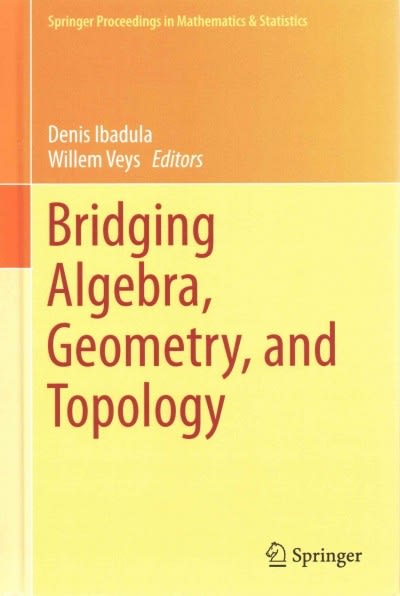Question
GIVE COMPLETE ANSWERS AND EXPLANATION AND ILLUSTRATION 1)Determine the probabilities of: (a) drawing a white ball from a bag containing 6 black and 14 white
GIVE COMPLETE ANSWERS AND EXPLANATION AND ILLUSTRATION
1)Determine the probabilities of: (a) drawing a white ball from a bag containing 6 black and 14 white balls (b) winning a prize in a raffle by buying 6 tickets when a total of 480 tickets are sold (c) selecting at random a female from a group of 12 boys and 28 girls (d) winning a prize in a raffle by buying 8 tickets when there are 5 prizes and a total of 800 tickets are sold. (8) 7. The probabilities of an engine failing are given by: p1, failure due to overheating; p2, failure due to ignition problems; p3, failure due to fuel blockage. When p1 = 1 , determine the probabilities of: (a) all three failures occurring (b) the first and second but not the third failure occurring (c) only the second failure occurring (d) the first or the second failure occurring but not the third.
2) A company produces five products in the following proportions: Product A 24 Product B 16 Product C 15 Product D 11 Product E 6 Present these data visually by drawing (a) a vertical bar chart (b) a percentage component bar chart (c) a pie diagram. (13) The following lists the diameters of 40 components produced by a machine, each measured correct to the nearest hundredth of a centimeter: 1.39 1.36 1.38 1.31 1.33 1.40 1.28 1.40 1.24 1.28 1.42 1.34 1.43 1.35 1.36 1.36 1.35 1.45 1.29 1.39 1.38 1.38 1.35 1.42 1.30 1.26 1.37 1.33 1.37 1.34 1.34 1.32 1.33 1.30 1.38 1.41 1.35 1.38 1.27 1.37 (a) Using 8 classes form a frequency distribution and a cumulative frequency distribution. (b) For the above data draw a histogram, a frequency polygon and an ogive. (21) Determine for the 10 measurements of lengths shown below: (a) the arithmetic mean, (b) the median, (c) the mode, and (d) the standard deviation. 28 m, 20 m, 32 m, 44 m, 28 m, 30 m, 30 m, 26 m, 28 m and 34 m (10) 4. The heights of 100 people are measured correct to the nearest centimetre with the following results: 150-157 cm 5 158-165 cm 18 166-173 cm 42 174-181 cm 27 182-189 cm 8 Determine for the data (a) the mean height and
3)In a particular street, 80% of the houses have telephones. If two houses selected at random are visited, calculate the probabilities that (a) they both have a telephone and (b) one has a telephone but the other does not have telephone. [(a) 0.64 (b) 0.32]. Veroboard pins are packed in packets of 20 by a machine. In a thousand packets, 40 have less than 20 pins. Find the probability that if 2 packets are chosen at random, one will contain less than 20 pins and the other will contain 20 pins or more. [0.0768]. A batch of 1 kW fire elements contains 16 which are within a power tolerance and 4 which are not. If 3 elements are selected at random from the batch, calculate the probabilities that (a) all three are within the power tolerance and (b) two are within but one is not within the power tolerance.
4) An amplifier is made up of three transistors, A, B and C. The probabilities of A, B or C being defective are 1 20, 125 And 1 50, respectively. Calculate the percentage of amplifiers produced (a) which work satisfactorily and (b) which have just one defective transistor. (a) 89.38% (b) 10.25% . A box contains 14 40 W lamps, 28 60 W lamps and 58 25 W lamps, all the lamps being of the same shape and size. Three lamps are drawn at random from the box, first one, then a second, then a third. Determine the probabilities of: (a) getting one 25 W, one 40 W and one 60 W lamp, with replacement, (b) getting one 25 W, one 40 W and one 60 W lamp without replacement, and (c) getting either one 25 W and two 40 W or one 60 W and two 40 W lamps with replacement.
5. (a) Find the probability of having a 2 upwards when throwing a fair 6-sided dice. (b) Find the probability of having a 5 upwards when throwing a fair 6-sided dice. (c) Determine the probability of having a 2 and then a 5 on two successive throws of a fair 6-sided dice. Determine the probability that the total score is 8 when two like dice are thrown. The probability of event A happening is 35 and the probability of event B happening is 23 .Calculate the probabilities of (a) both A and B happening, (b) only event A happening, i.e. event happening and event not happening, (c) only event B happening, and (d) either A, or B, or A and B happening.
Step by Step Solution
There are 3 Steps involved in it
Step: 1

Get Instant Access to Expert-Tailored Solutions
See step-by-step solutions with expert insights and AI powered tools for academic success
Step: 2

Step: 3

Ace Your Homework with AI
Get the answers you need in no time with our AI-driven, step-by-step assistance
Get Started


